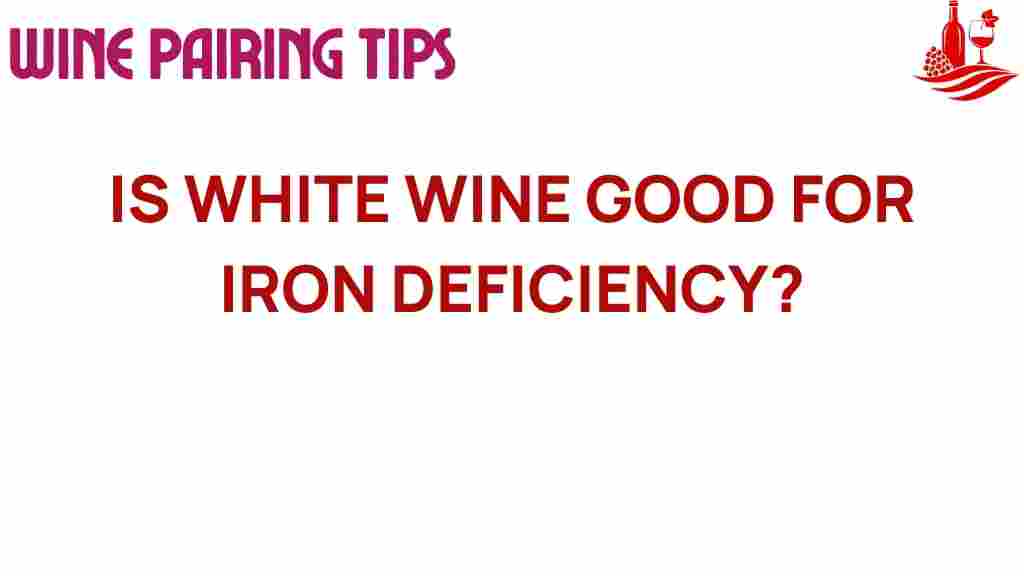Can White Wine Boost Your Iron Levels? Discover the Truth!
Iron deficiency is a common health concern that affects millions of people worldwide. Many individuals are constantly searching for ways to improve their iron levels through various dietary choices. One intriguing question that has surfaced is whether white wine can boost your iron levels. In this article, we will explore the relationship between white wine, iron absorption, and overall health benefits, as well as the role of antioxidants found in wine nutrition.
Understanding Iron Deficiency
Iron deficiency occurs when the body doesn’t have enough iron to produce adequate hemoglobin, the protein in red blood cells that carries oxygen. Symptoms of iron deficiency can include:
- Fatigue and weakness
- Pale skin
- Shortness of breath
- Dizziness or lightheadedness
- Cold hands and feet
Correcting iron deficiency is crucial for maintaining optimal health and wellness. Incorporating iron-rich foods into your diet is a common approach, but many are curious about the potential effects of beverages like white wine on iron absorption.
White Wine and Wine Nutrition
White wine, like all alcoholic beverages, is made through the fermentation of grapes. While red wine often gets the spotlight for its potential health benefits, white wine also contains various nutrients and antioxidants. Here are some components of white wine that may influence your health:
- Antioxidants: White wine contains antioxidants, which can help combat oxidative stress in the body.
- Polyphenols: These compounds may have anti-inflammatory properties and can support cardiovascular health.
- Low in Calories: White wine is typically lower in calories compared to many sugary beverages, making it a favorable choice for those watching their caloric intake.
The Connection Between White Wine and Iron Absorption
While white wine has several health benefits, its relationship with iron absorption is more complex. Here are some key points to consider:
- Iron Sources: To boost your iron levels, it’s essential to consume iron-rich foods such as red meat, poultry, fish, legumes, and leafy greens.
- Impact of Alcohol: Some studies suggest that moderate alcohol consumption may improve iron absorption; however, excessive alcohol can lead to liver damage, which negatively impacts overall health.
- Role of Polyphenols: The polyphenols found in white wine can potentially inhibit iron absorption, particularly non-heme iron (the type found in plant-based foods).
Given these factors, it’s essential to approach the idea of using white wine as a means to boost iron levels with caution. While moderate consumption may have some benefits, it should not replace iron-rich foods in your diet.
Step-by-Step: Improving Iron Levels with Dietary Choices
If you are looking to improve your iron levels, consider the following step-by-step guide that incorporates healthy dietary choices:
- Assess Your Iron Levels: Consult with a healthcare professional to determine if you are iron deficient and what your current levels are.
- Include Iron-Rich Foods: Focus on adding iron-rich foods to your meals, such as:
- Red meat
- Poultry
- Fish
- Beans and lentils
- Spinach and other leafy greens
- Coffee and tea
- Calcium-rich foods consumed simultaneously with iron sources
- High-fiber foods that contain phytates
Troubleshooting Tips for Iron Deficiency
If you’re struggling with iron deficiency despite making dietary changes, consider the following troubleshooting tips:
- Consult a Specialist: If your iron levels remain low, speak with a healthcare provider about potential supplements or further testing.
- Monitor Your Diet: Keep a food diary to track your iron intake and identify patterns or gaps in your diet.
- Consider Cooking Methods: Use cast iron cookware, which can increase the iron content of your food.
- Evaluate Your Habits: Reduce alcohol consumption if you suspect it may be affecting your health and iron absorption.
By making informed dietary choices and being mindful of how you pair foods and beverages, you can effectively manage your iron levels and enhance your overall wellness.
Conclusion: The Role of White Wine in a Healthy Diet
In conclusion, while white wine has numerous health benefits and can be enjoyed as part of a balanced diet, it should not be relied upon as a primary source for boosting iron levels. Iron deficiency is best addressed through a combination of iron-rich foods, proper pairing with vitamin C, and limiting inhibitors of iron absorption. If you’re considering adding white wine to your dietary choices, do so in moderation and always prioritize your health needs.
For further reading on dietary choices that can improve your health, check out this comprehensive guide on nutrition. Remember, your wellness journey is unique, and it’s always best to consult with a healthcare professional to tailor your approach to your individual needs.
By understanding the effects of different foods and beverages, including white wine, on your body, you can make informed decisions that support your overall health and well-being.
This article is in the category Tips and created by Wine Pairing Tips Team
